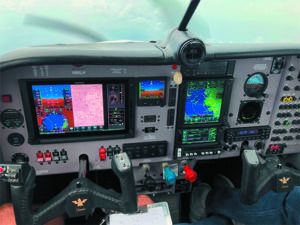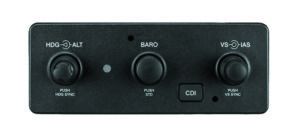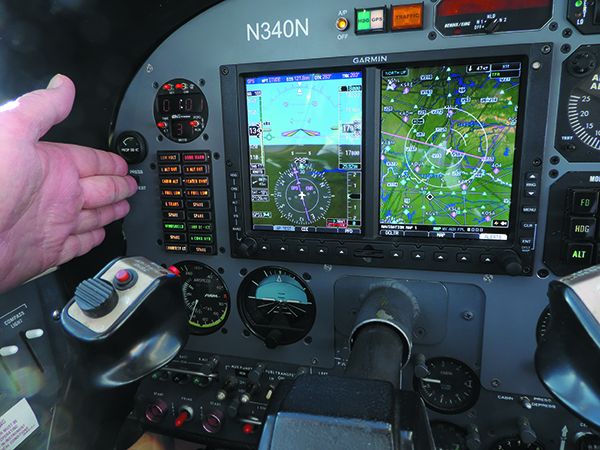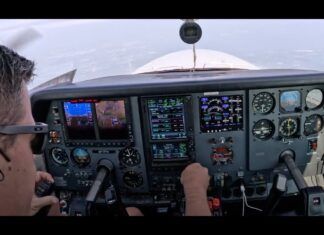I was quite happy with the installation of the Garmin G500 TXi in my Mooney and when it was time to fly the new panel, realized the TXi can be configured in many ways, but the most common is the PFD on the left and the MFD on the right. Each screen has a dedicated concentric knob. When displaying simultaneously the PFD and MFD, the knobs control the relevant display.
During the panel layout process, I decided to add an optional control head for remotely controlling many of the PFD functions. The TXi allows two ways to handle most of the PFD functions—through touchscreen and through a dual concentric knob very similar to other Garmin products. The optional controller added dedicated buttons and knobs including heading bug, altimeter set and altitude preselect controls.
But there was a big problem that was not obvious to me at first. The heading bug control is located in the PFD control knob, now hidden behind the pilot’s yoke on the left side. To reach it, I had to move my right hand over the yoke, blocking out most of the PFD with my arm in a defensive position just to change the bug. I could also try to reach the knob using my left hand, which required a bit of contorting my hand—awkward when hand flying while using the left hand to fly.
A relatively easy solution was to flip the display in the configuration mode, PFD to the right, MFD to the left. In my case, this was never really an issue because the controller has a dedicated HDG bug that was easily accessible. I was lucky in that I decided to get the controller in the first place. However, I was completely unaware of the impact of the decision until the first flight. I mentioned this ergonomics issue (specifically the G500 TXi heading bug function) to Garmin at AirVenture as feedback.
Fast-forward to December 2020. New software for the G500 TXi was installed, and it now allows the MFD knob to toggle between MFD and PFD modes, adding more flexibility. However, the PFD knob remains dedicated to the PFD only. I did ask Garmin why the PFD knob is not able to toggle and got the standard response having something to do with certification.
My recommendation related to ergonomics is that placement of the components (and their accessibility to the controls) needs to be considered very seriously as part of any upgrade, but especially when stepping up from round gauges to glass. This is especially important to nail before any metal is cut for a new panel. Typically, an actual-size engineering drawing is first produced. It is great to see what the panel might look like, but because it is only a drawing, the rendering is not good enough as it is hard to visualize the controls, especially in the third dimension.
Work with avionics shops that allow customers to interact with the technicians. You can learn a lot from them. If the avionics shop also has pilots, that is even better.
—Luca Bencini

Sometimes the most well-thought-out layout—and avionics component design—creates some minor nuisances. For instance, in my Garmin-equipped Cessna 340, all the knobs on the PFD that adjust the heading, altitude, and such are on the left side of the bezel, where they sit just above the left horn of the control yoke.
So, when acknowledging a new heading or altitude, I’d be pushing the PTT on the yoke with my left hand, while awkwardly reaching all the way across to the left side of the panel with my right hand to make the adjustment. Even while the autopilot is flying, this cockpit version of the game Twister is a bother.

That’s until I mounted a parallel push-to-talk switch on the center console. Now, I can hit the PTT with my right hand and naturally adjust the heading or altitude with my right. Problem solved—but not without some shop labor.
—Frank Bowlin


